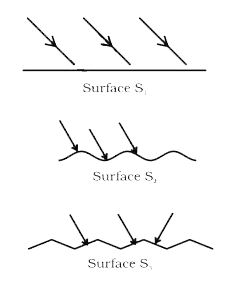A plane monochromatic light wave with wavelength λ falls on the surface of a glass wedge whose faces from an angle α<<1. The plane of incidence is perpendicualr to the edge, the angle of incidence is θ1. Find the distance between the neighbouring fringe maxima on the screen placed at right angles to reflected light.
We have usual equation fro maxima
2hkα√n2−sin2θ1=(k+12)λ
Hence hk= distance of the fringe from top
hkα=dk= thickness of the film
Thus on the screen placed at right angles to the reflected light
Δx=(hk−hk−1)cosθ1
=λcosθ12α√n2−sin2θ1

Topper's Solved these Questions
- BOOK - IE IRODOV, LA SENA & SS KROTOVCHAPTER - OPTICSEXERCISE - Diffraction Of Light60videos
OPTICS
- BOOK - IE IRODOV, LA SENA & SS KROTOVCHAPTER - OPTICSEXERCISE - Polarization Of Light43videos
OPTICS
- BOOK - IE IRODOV, LA SENA & SS KROTOVCHAPTER - OPTICSEXERCISE - Exercise2videos
OPTICS
- BOOK - IE IRODOV, LA SENA & SS KROTOVCHAPTER - MECHANICSEXERCISE - Mechanics Problems92videos
MECHANICS
- BOOK - IE IRODOV, LA SENA & SS KROTOVCHAPTER - OSCILLATIONS AND WAVESEXERCISE - Electromagnetic Waves, Radiation36videos
OSCILLATIONS AND WAVES
Similar Questions
A plane light wave with wavelength λ=0.60μm falls normally on the face of a glass wedge with refracting angle Θ=15∘. The opposite face of the wedge is opaque and has a slit of width b=10μm parallel to the edge. Final:
(a) the angle Δθbetween the direction to the Fqaunhofer maximum of zeroth order and that of incident light,
(b) the angular width of the frqunhofer maximum of the zeroth order.View SolutionA plane light wave with wavelength λ=0.50μm falls normally on the face of a glass wedge with an angle Θ=30∘. On the opposite face of the wedge a transparent diffraction grating with period, d=2.00μm is inscibed, whose lines are parallel to the wedge's edge. Find the angles that the direction of incident light froms with the directions to the principle Fraunhofer maxima of the zero and the first order. waht is the highest order of the spectrum? At what angle to the direction of incident light of the observed?
View Solution
Knowledge Check
- Question 1 - Select One
Light is falling on the surfaces S1,S2andS3 as shown below.

The surfaces on which the angle of incidence is equal to the angle of reflection areAS1andS3BAll the three surfacesCS1andS2DS2andS3 - Question 2 - Select One
Light is falling on the surfaces S1,S2andS3 as shown below.

The surfaces on which the angle of incidence is equal to the angle of reflection areAS1andS3BAll the three surfacesCS1andS2DS2andS3 - Question 3 - Select One
Light is falling on the surfaces S1,S2andS3 as shown below:

The surfaces on which the angle of incidence is equal to the angle of reflection areAS1andS2BS2andS3CS1andS3DAll the three surfaces
Light is falling on surface S1, S2, S3 as shown in Fig.16.1.

Surfaces on which the angle of incidence is equal to the angle of reflection is/areView SolutionIf a light ray incident on a plane mirror makes an angle 30∘ with it, find the angle of incidence and angle of reflection.
 View Solution
View SolutionIf a light ray incident on a plane mirror makes an angle 30∘ with it, find the angle of incidence and angle of reflection.
 View Solution
View SolutionIn order that the light reflected from the surface of a medium of refractive index μ is plane polarized, the angle of incidence should be :
View SolutionIn order that the light reflected from the surface of a medium of refractive index μ is plane polarized, the angle of incidence should be :
View Solution

